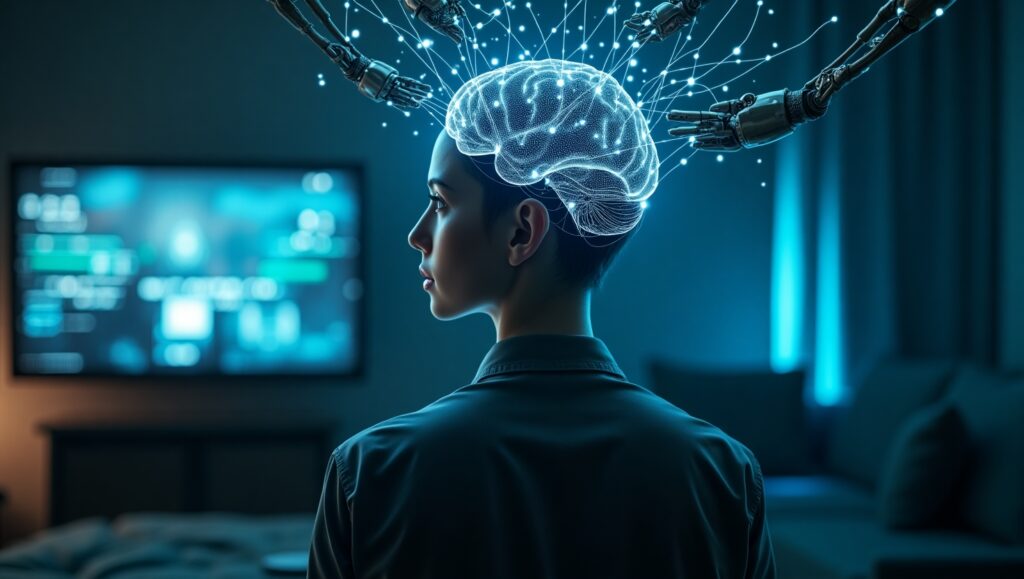We scroll, click, and choose—often unaware that artificial intelligence has become the silent architect of our daily choices. From Netflix recommendations to healthcare diagnostics, AI systems increasingly mediate human cognition, creating a paradigm where algorithms don’t just assist decisions but actively reshape them. This subtle interplay between AI and human behavior is forging a new reality, one where technology doesn’t merely serve us, but also steers how we think, evaluate, and act. As Reid Hoffman, LinkedIn co-founder, noted: “AI is going to reshape every industry and every job.” Yet beneath this transformation lie urgent questions about autonomy, ethics, and the future of human agency.
The Emergence of “System 0”: AI as an External Brain
Human cognition traditionally operates through two systems: intuitive, fast-thinking System 1 and analytical, deliberate System 2. Now, AI introduces “System 0”—an external cognitive layer processing vast data beyond human capacity. This framework, highlighted by neuroscientists, enables AI to augment intuition and analysis3. For instance:
- Fluid intelligence enhancement: AI like François Chollet’s ARC-AGI test measures adaptability to novel problems, pushing machines toward human-like reasoning.
- Hybrid decision-making: IBM’s Watson analyzes patient data to recommend treatments, but doctors retain final authority—a model blending AI efficiency with human judgment.
However, System 0 risks creating dependency. Studies show over-reliance on AI can erode critical thinking, mirroring historical concerns about “catastrophic forgetting” in neural networks. As psychologist Ericka Rovira warns: “We cannot trade magic for the explainable” when lives are at stake.
Digital Nudging: The Invisible Hand of Algorithms
AI’s most potent behavioral tool is digital nudging—subtle cues steering choices without overt coercion. These techniques, derived from behavioral psychology, include:
| Nudge Type | Mechanism | Real-World Example |
|---|---|---|
| Social proof | Leverages peer influence | TripAdvisor’s user reviews |
| Scarcity/urgency | Creates fear of missing out | Amazon’s “Only 3 left!” alerts |
| Personalization | Tailors options to past behavior | Netflix’s viewing suggestions |
These nudges exploit cognitive biases. For example, Spotify’s default auto-renewal settings exploit inertia, while LinkedIn’s engagement-driven feed fosters “echo chambers”. The result? Algorithms don’t just reflect preferences—they shape them, often prioritizing corporate profits over user well-being.
Cognitive Trade-offs: Efficiency vs. Autonomy
AI’s decision-making prowess carries a hidden cost: cognitive offloading. When AI handles complex tasks (e.g., data analysis or strategic planning), human skills atrophy. Research confirms this:
- Diminished critical thinking: Walmart’s AI-driven recruitment reduces human evaluative roles, potentially eroding judgment muscles.
- Memory and intuition loss: Education platforms minimizing teacher-student interaction weaken students’ problem-solving “cognition power”.
Elon Musk starkly frames the risk: “AI is a fundamental risk to the existence of human civilization” if uncontrolled1. Yet not all is dire. Hybrid models—like Tesla’s autonomous cars requiring human oversight—balance efficiency with agency.
Ethical Fault Lines: Bias, Transparency, and Power
AI’s behavioral influence intensifies ethical dilemmas:
- Bias amplification: Algorithmic hiring tools often inherit societal prejudices, disadvantaging marginalized groups. Karen Mills, Harvard Business School fellow, cautions: “If we’re not thoughtful, we’ll end up with redlining again”.
- Opacity in decision-making: “Black box” algorithms, like those in criminal sentencing, obscure rationale, complicating accountability.
- Privacy erosion: Wearable AI in mental health monitoring risks exposing sensitive biometric data.
Ethical frameworks like APA’s AI Ethics Principles—emphasizing justice, transparency, and beneficence—offer guardrails. But as Salesforce’s Ahyoung An observes, “Legal liability keeps humans in the loop”—for now.
AI and Human Behavior Real-World Impact: Case Studies in Behavioral Shifting
AI’s behavioral rewiring manifests across sectors:
- Healthcare: IBM Watson processes medical journals to suggest treatments, yet doctors like those at Mayo Clinic contextualize recommendations for patient-specific care.
- Finance: JPMorgan Chase’s AI accelerates investment analysis, but traders intervene during market volatility.
- Consumer Behavior: Amazon’s anticipatory shipping—predicting purchases before checkout—exemplifies AI’s power to mold economic choices.
These cases reveal a pattern: AI handles data-heavy lifting, while humans provide ethical and contextual nuance. Netflix’s content personalization boosts engagement, but it’s true impact lies in normalizing algorithmic curation of cultural consumption.

Reclaiming Agency: Strategies for Conscious Engagement
Combating AI’s passive influence requires proactive tactics:
- Algorithmic literacy: Understand how platforms like Instagram use engagement metrics. Curate feeds to prioritize learning over distraction.
- Boundary-setting: Use tools like the EU’s Digital Services Act to disable personalized recommendations or limit data sharing.
- Diversified inputs: Break filter bubbles by intentionally seeking contrarian viewpoints.
- Ethical design advocacy: Support AI development prioritizing explainability (e.g., APA’s transparency standards).
Sheryl Sandberg’s insight resonates here:
AI requires “collaboration of human creativity and machine learning” to solve global challenges.
Conclusion: The Delicate Balance of Augmented Cognition
AI’s quiet revolution in human decision-making is irreversible—and not inherently malign. It enhances medical diagnoses, democratizes education, and tackles climate change. Yet its power demands vigilance. As Satya Nadella asserts, AI must “reflect human values”. The future hinges on a symbiotic relationship: leveraging System 0’s computational might while nurturing System 2’s critical introspection. In this dance between silicon and synapse, our task isn’t to resist augmentation but to steer it—ensuring AI elevates, rather than eclipses, the human mind.
References
- https://time.com/partner-article/7279245/15-quotes-on-the-future-of-ai/
- https://theconversation.com/how-psychologists-kick-started-ai-by-studying-the-human-mind-248542
- https://neurosciencenews.com/ai-human-decision-thought-28911/
- https://capturly.com/blog/how-to-build-trust-with-digital-nudging-beginner-guide/
- https://gaper.io/ethical-ai-impact-decision-making/
- https://www.larksuite.com/en_us/topics/ai-glossary/ethical-implications-of-artificial-intelligence
- https://news.harvard.edu/gazette/story/2020/10/ethical-concerns-mount-as-ai-takes-bigger-decision-making-role/
- https://www.linkedin.com/pulse/ai-powered-decision-making-case-studies-jaideep-matto-1ncgc
- https://digitaldefynd.com/IQ/artificial-intelligence-case-studies/
- https://papers.ssrn.com/sol3/papers.cfm?abstract_id=5019283
- https://www.apa.org/monitor/2025/01/trends-harnessing-power-of-artificial-intelligence
- https://www.linkedin.com/pulse/subtle-art-algorithmic-influence-reclaiming-control-from-salma-noun-tc6sf
- https://www.forbes.com/sites/tomchavez/2023/02/23/how-we-can-and-should-regain-control-of-the-recommendation-algorithm/
- https://www.linkedin.com/pulse/artificial-intelligence-ai-human-behaviors-saber-oujani-vqu2c
- https://www.forbes.com/sites/lanceeliot/2022/09/03/unpacking-the-best-top-ten-quotes-about-artificial-intelligence-leveraging-modern-day-ai-ethics-thinking/
- https://www.bbva.com/en/innovation/how-ai-can-also-empower-the-behavioral-sciences/
- https://blogs.lse.ac.uk/businessreview/2025/01/03/ai-is-revolutionising-decision-making-but-it-cant-replace-human-leaders/
- https://www.propulsiontechjournal.com/index.php/journal/article/view/492
- https://www.longdom.org/open-access/cognitive-neuroscience-and-artificial-intelligence-resolving-the-mindmachine-connection-1099555.html
- https://www.sap.com/resources/what-is-ai-ethics
- https://www.inc.com/peter-economy/21-quotes-on-the-promise-and-the-peril-of-artificial-intelligence/91191432
- https://evolutionoftheprogress.com/ai-and-human-thinking/
- https://bernardmarr.com/28-best-quotes-about-artificial-intelligence/
- https://journal.iujharkhand.edu.in/December-2023/Exploring-Human-Thinking-with-Techniques-of-Artificial-Intelligence.html
- https://www.accelirate.com/is-ai-influencing-human-mind/
- https://deliberatedirections.com/quotes-about-artificial-intelligence/
- https://www.goodreads.com/work/quotes/67871237-the-algorithmic-leader-how-to-be-smart-when-machines-are-smarter-than-y
- https://www.linkedin.com/pulse/algorithms-ethics-nicolas-roope
- https://www.downtoearth.org.in/science-technology/ai-is-changing-the-way-we-think
- https://indatalabs.com/blog/artificial-intelligence-decision-making


